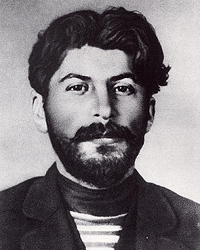
- Young Stalin
- McArthur & Company (2007)
In World War II he was Uncle Joe, our beloved ally against Nazism. Then he was the face of the Red Menace, and for decades after his death in 1953 he seemed to rule the Soviet Union. Khrushchev's 1956 speech discredited Stalin, but was itself pure Stalinism: advance yourself by destroying your onetime comrade.
One hundred and thirty years after his birth, Josef Stalin remains a present force. Saddam Hussein modelled his regime on Stalin's. Countless Russians still admire him and look back on his era as a golden age.
So his life deserves study -- for what he did to create our world, and for what he tells us about ourselves. Stalin was not a monster. He was a man capable of monstrosities, and capable of making others commit monstrosities as well. He was not the last of his kind.
The hero of a family saga
Simon Sebag Montefiore published Stalin: The Court of the Red Tsar in 2004. It's a fascinating account of Stalin in power, ruling and ruining the Soviet Union. Drawing on newly opened Russian archives, Montefiore found remarkably detailed and personal records, many by Stalin's own victims. The result was a page-turner of a family saga, complete with suicidal wives, drunken sons, and priapic psychopaths.
Now he's used the same techniques in the forgotten archives of Georgia and the other new Caucasian republics. His friends and associates left memoirs of the young Soso Djugashvili they'd known in the two turbulent decades around the turn of the 20th century. In Young Stalin, we again have an account that is exciting, suspenseful, and finally unsatisfying.
With such material, the excitement comes easily. Montefiore starts with a famous 1907 bank robbery in Tiflis (modern Tbilisi). Stalin had organized it brilliantly, using revolutionaries, gangster, pistol-packing teenage girls, and street urchins. The heist gained hundreds of thousands of rubles, cost 40 lives, and made headlines across Europe.
More importantly, it helped fund the revolutionary activities of Vladimir Ilyich Lenin, the exiled leader of the Bolshevik faction of the Social Democrat party. So did other robberies (some of ships on the Black Sea) that Stalin planned.
Montefiore does a brilliant job of creating the context for this young brigand: a grim childhood in a primitive Caucasian town where drunken brawls were the chief form of entertainment. His father was a drunk. After losing two sons, his mother was overprotective of the one who lived.
Growing up tough and intelligent
Young Soso grew up both tough and intelligent. Though he was not the son of a priest, his mother wangled him a place in a seminary where he could get the best possible education. He was a brilliant student, and a promising poet whose first works won prompt publication. But he soon learned contempt for his clerical teachers, and for the social order they helped uphold. He read forbidden authors like Zola, broke the rules, and still quit under his own terms.
Marx gave him a political philosophy, but he despised the would-be radicals who talked but did nothing. Lenin's famous pamphlet, What is to be done?, gave Soso both an agenda and a leader.
But he still had time to carouse. The early Reds were party animals in more ways than one. Women liked his looks, his wit, and his literary talent. Men liked his toughness, his magnetism, and his ability to drink. Yet he could abandon his girlfriends (and his children), and reward or punish his old friends almost at whim.
Montefiore shows us a young man both self-absorbed yet acutely perceptive of other people's characters. His frequent spells in jail were mere study breaks, and he always became the de facto boss of prisoners and guards alike.
Adapted to chaotic times
Given the tenor of the times, Soso was superbly adapted. During the Russo-Japanese War in 1905, the Russian Empire staggered from one defeat to another. Sensing the government's weakness, criminals and revolutionaries alike ran wild. The Caucasus in 1905 sounds amazingly like Iraq in 1955 or 2005: a violent world of tribal hostility, bottomless corruption, huge oil wealth, pogroms, and spasms of brutal repression. No wonder Saddam Hussein emulated Stalin.
Konspiratsia was the only way for revolutionaries to survive, but the Tsar's Okhrana was equally brilliant at it. While the secret police picked off Stalin's comrades, and then Stalin himself, the Reds killed their own loyal comrades but trusted the turncoats. Discovering this only made the Reds even more paranoid.
Exiled to Siberia, Stalin escaped more than once; he attended party meetings in Western Europe, including one in London just weeks before the Tiflis bank robbery.
But he spent most of World War I deep in Siberia, where escape was impossible and survival itself was difficult. Yet his comrades and friends sent him money and warm clothes, he shacked up with a teenager, and local tribesmen taught him how to hunt and fish. He returned to Petrograd a tougher and more competent revolutionary than ever.
The revolution that almost failed
The book's narrative of the two-stage Russian Revolution is suspenseful and surprising. The Bolsheviks' coup was a near-run thing, and could have failed. Its success was largely thanks to Stalin's unswerving loyalty to Lenin and willingness to work hard and ruthlessly.
Montefiore makes those months in 1917 almost painfully vivid. Raging at his gentler comrades in the moment of victory, Lenin snarled: "What's the point of a revolution if you can't shoot people?"
So Young Stalin is very much worth reading, and a fine prequel to Montefiore's earlier biography. But in one crucial aspect, both books fail.
They persuade us that Josef Stalin was that rarity, a genuinely intellectual tyrant. Ideas mattered to him. In exile, he hungered for books more than for warm clothes. He loved and respected literature. As one of his victims observed, Stalin's Russia took poetry so seriously you could get killed for writing it.
Yet Montefiore's books pay almost no attention to the ideas that inspired Stalin to launch into a career that would kill tens of millions.
What made revolution look good?
Yes, Tsarist Russia was an awful place, and the advanced industrial nations weren't much better. We've forgotten that before the fall of the Berlin Wall, capitalism had a century-long problem: It could market almost anything except itself.
But what made Stalin, Lenin, and millions of ordinary people think that Marxism would be any better? Why did its awful jargon resonate in the hearts and minds of German steelworkers and Chinese peasants and Hollywood screenwriters?
Whatever the reason, in 30 years Marxism swept from Petrograd to Beijing to Berlin and Belgrade -- far faster than Islam moved from Mecca to India and the Pyrenees. Its geographical success lent credence to its ideas. In name, at least, Marxism still governs well over a billion people.
Montefiore has a Chekhovian brilliance in showing us the difficult son of a difficult mother: "You should have become a priest," she told him in the 1930s, when he ruled from the Baltic to the Pacific.
But if we also understood how Stalin's ideas guided his career, we might be prepared to resist the next Stalin -- who may now be preparing himself in some Pakistani madrassa or American university, knowing us well enough to make us commit still more monstrosities for his sake.




